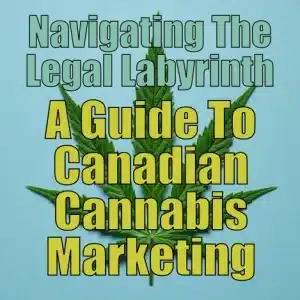 As seasoned online marketers who have navigated the ever-changing digital landscape for a quarter-century, we have seen countless industries adapt to new regulations and market dynamics. The legalization of cannabis in Canada presented a unique challenge, creating a nascent industry with a built-in marketing paradox: a legal product with severe restrictions on how it can be promoted. For cannabis businesses, particularly dispensaries, mastering dispensary marketing is not about traditional ad campaigns; it is about strategic compliance and leveraging digital channels in a layered, complex way.
As seasoned online marketers who have navigated the ever-changing digital landscape for a quarter-century, we have seen countless industries adapt to new regulations and market dynamics. The legalization of cannabis in Canada presented a unique challenge, creating a nascent industry with a built-in marketing paradox: a legal product with severe restrictions on how it can be promoted. For cannabis businesses, particularly dispensaries, mastering dispensary marketing is not about traditional ad campaigns; it is about strategic compliance and leveraging digital channels in a layered, complex way.
This guide serves as a foundational resource, breaking down the key prohibitions under the federal Cannabis Act and offering insights into the limited, yet powerful, ways you can build your brand and attract customers.
The Prohibitions: Understanding What You Can’t Do
The Prohibitions: Understanding What You Can’t Do
The foundation of Canadian cannabis marketing law is a “do not” list. The regulations are designed to protect public health and safety, with a particular focus on preventing youth access and discouraging excessive use. To succeed in dispensary marketing, you must first internalize these core prohibitions:
- No Glamorizing the Product The law strictly prohibits any promotion that associates cannabis with a “way of life” that includes glamour, recreation, excitement, vitality, risk, or daring. This means you cannot show people partying, skydiving, or engaging in any activity that suggests cannabis enhances a thrilling or aspirational lifestyle. Your marketing must be grounded in factual information, not emotion or fantasy.
- No Appeals to Youth This is a zero-tolerance area. All promotional materials, from your website design to in-store signage, must be created with the understanding that they cannot be appealing to minors. This includes a ban on using cartoon characters, bright and vibrant colours, certain types of fonts, or imagery that could be seen as targeting a younger demographic. An age-gate on your website is a necessity, but it is just the first step in a broader responsibility to avoid youth-centric marketing.
- No Testimonials or Endorsements You cannot use testimonials or endorsements, whether from a celebrity, an influencer, or a regular customer. The law is explicit on this point to prevent the perception of credibility or social proof that could influence consumption. This means you must be careful with how you feature customer reviews, ensuring they don’t function as a promotional endorsement of the product itself.
- No Misleading Health Claims Dispensary marketing must be factual and accurate. You are prohibited from making any claims about the health effects, benefits, or risks of cannabis that are not backed by scientific evidence and authorized by Health Canada. This is a critical point for dispensaries that also sell CBD products or other wellness-focused items. Stick to what is demonstrably true about your products and services, not what they might “do” for a customer’s health.
The Permissions: Strategic, Compliant Promotion
The Permissions: Strategic, Compliant Promotion
While the prohibitions are extensive, that does not mean marketing is impossible. Instead, the prohibitions force businesses to be both creative and strategic. The law carves out specific, limited exceptions that are the keys to effective dispensary marketing.
- Informational Promotion This is the lifeblood of compliant cannabis marketing. You are allowed to provide factual information about your products, their characteristics, and their availability. This is where SEO expertise becomes invaluable. Through well-researched, high-quality content, you can educate your audience. Think blog posts explaining the difference between different strains, articles on terpene profiles, or guides on the types of cannabis products available. This approach establishes your business as a knowledgeable and trustworthy resource without breaking the law.
- Brand-Preference Promotion You can and should focus on building your brand identity. Since you cannot promote the effects of the product, you must promote the quality of your business. This is about building brand loyalty and trust. Consider the in-store experience: a clean, professional, and welcoming environment can be a powerful marketing tool. Your brand identity can be reflected in your logo, your packaging, and your overall customer service. All within the strict regulatory framework.
- Point-of-Sale Marketing Within a licensed retail location, you are permitted to communicate pricing and product availability. This is your most direct opportunity for promotion. The law allows for promotional materials inside the store, but they must still comply with the other rules—no glamour, no youth appeal, and no health claims. This is where you can showcase new arrivals and make direct pitches to customers who have already verified their age and intent.
In conclusion, “dispensary marketing” in Canada is a discipline of careful navigation and strategic restraint. It’s not about being loud; it’s about being smart. By focusing on informational content, building a strong and compliant brand identity, and optimizing the in-store experience, dispensaries can effectively grow their business while respecting the legal boundaries.
The most common mistakes are often rooted in misunderstanding the core prohibitions of the Cannabis Act. Businesses frequently make the error of using promotional language that is too emotional or aspirational, such as associating their products with a “glamorous” lifestyle. They may also unknowingly appeal to youth by using certain fonts, colors, or imagery, or make unsubstantiated health claims about their products. Another critical mistake is using testimonials or endorsements, which are strictly forbidden.
Yes, but with extreme caution and a focus on compliance. The key is to use social media for community building and education, not direct promotion. You can post factual content, such as information about strains, terpene profiles, or your business hours. However, you cannot run paid advertisements, use influencers, or create content that glamorizes the product or appeals to youth. Your social media strategy should prioritize building a brand presence and engaging with a verified, age-gated audience in a compliant manner.
Building a brand in the cannabis space is all about what we call “brand-preference promotion.” Instead of focusing on the product’s effects, you should focus on the quality of your business. This means creating a strong brand identity through your logo, store design, and customer service. You can market your expertise, your commitment to quality products, and the unique experience your dispensary offers. Your brand becomes a symbol of trust and reliability, which is often more powerful than any direct promotional message.
Absolutely. SEO is one of the most effective and compliant tools for dispensary marketing. By creating high-quality, informational content on your website, you can attract organic traffic from people searching for terms like “indica vs. sativa” or “what are terpenes.” Additionally, local SEO is crucial. Optimizing your Google Business Profile and website for local searches like “dispensary near me” ensures that potential customers in your area can find you easily when they are ready to make a purchase.
Yes, and you should. A blog is an excellent tool for informational promotion, which is one of the limited ways you can legally market your business. You can use a blog to educate your audience on a wide range of topics, from cannabis history and the science of the plant to guides on different consumption methods. This not only provides value to your customers but also helps improve your search engine rankings, making your business a trusted authority in the space. Remember to keep the content factual, educational, and completely free of any glamorization or health claims.
